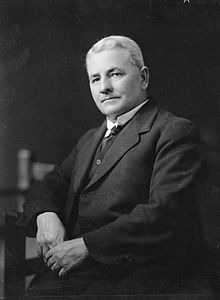The 1919 New Zealand general election was held on Tuesday, 16 December in the Māori electorates and on Wednesday, 17 December in the general electorates to elect a total of 80 MPs to the 20th session of the New Zealand Parliament. A total number of 560,673 (80.5%) voters turned out to vote.[1]
| |||||||||||||||||||||||||||||||||||||||||||||||||||||
All 80 seats in the New Zealand House of Representatives 41 seats were needed for a majority | |||||||||||||||||||||||||||||||||||||||||||||||||||||
|---|---|---|---|---|---|---|---|---|---|---|---|---|---|---|---|---|---|---|---|---|---|---|---|---|---|---|---|---|---|---|---|---|---|---|---|---|---|---|---|---|---|---|---|---|---|---|---|---|---|---|---|---|---|
| Turnout | 80.5% | ||||||||||||||||||||||||||||||||||||||||||||||||||||
| |||||||||||||||||||||||||||||||||||||||||||||||||||||
 Results of the election. | |||||||||||||||||||||||||||||||||||||||||||||||||||||
| |||||||||||||||||||||||||||||||||||||||||||||||||||||
In 1919 women won the right to be elected to the House of Representatives. The law was changed late that year, and with only three weeks' notice, three women stood for Parliament.
They were Ellen Melville in Grey Lynn, Rosetta Baume in Parnell, and Aileen Cooke in Thames. Ellen Melville stood for the Reform Party and came second. She stood for Parliament several more times and generally polled well but never won a seat.
This is the most recent general election in which none of the major party leaders were born in New Zealand.
Results
editThough Labour Party captured only eight seats it received nearly a quarter of the votes – a shock to conservative minds due to Labour being founded only three years earlier in 1916.[2]
Party totals
edit| Election results | |||||
|---|---|---|---|---|---|
| Party | Candidates | Total votes | Percentage | Seats won | |
| Reform Party | 67 | 197,041 | 35.63 | 45 | |
| Liberal Party[nb 1] | 66 | 166,675 | 30.14 | 19 | |
| Labour Party | 59 | 134,094 | 24.25 | 8 | |
| Independents[nb 2] | 39 | 55,161 | 9.98 | 8 | |
| Total valid votes | 552,971 | 80 | |||
| Informal votes | 7,702 | 1.37 | |||
| Registered voters | 683,420 | ||||
- ^ Includes one MP returned unopposed, and one Independent Liberal
- ^ Includes ex-members of the three main parties as well as long-standing Independents
Votes summary
editElectorate results
editThe table below shows the results of the 1919 general election:
Key
| Reform | Liberal | Labour | Liberal–Labour | |||||
| Independent Liberal | Independent Labour | Independent | ||||||
Summary of changes
editA boundary redistribution resulted in the abolition of four electorates:[18]
- Grey, held by Harry Holland
- Otago Central, held by Robert Scott
- Selwyn, held by William Dickie
- Taumarunui, held by William Thomas Jennings
- Wellington Suburbs and Country, held by Robert Wright
At the same time, four new electorates were created:[19][20]
- Manawatu, previously abolished in 1911
- Roskill, first created through the 1918 electoral redistribution
- Rotorua, first created through the 1918 electoral redistribution
- Waitomo, first created through the 1918 electoral redistribution
- Wellington Suburbs, previously abolished in 1911
Notes
edit- ^ "General elections 1853–2005 – dates & turnout". Elections New Zealand. Archived from the original on 14 November 2014. Retrieved 12 January 2011.
- ^ Lipson 2011, p. 211.
- ^ Hislop, J. (1921). The General Election, 1919. National Library. pp. 1–6. Retrieved 6 December 2014.
- ^ a b c d Gustafson 1980, p. 181.
- ^ "Clutha". Otago Daily Times. No. 17779. 11 November 1919. p. 6. Retrieved 1 August 2020.
- ^ Dickson, Amanda Rodger (23 September 2011). "West Otago A & P Society". Amanda Rodger Dickson at Wordpress. Retrieved 1 August 2020.
- ^ Gustafson 1980, p. 155.
- ^ "The election campaign". Evening Star. No. 17218. 6 December 1919. p. 6. Retrieved 1 August 2020.
- ^ "Notice of nominations received". The Press. Vol. LV, no. 16701. 9 December 1919. p. 10. Retrieved 1 August 2020.
- ^ "Notice of Nominations Received". Hawke's Bay Tribune. Vol. IX, no. 303. 9 December 1919. p. 6. Retrieved 16 October 2015.
- ^ "Napier". Hawera & Normanby Star. Vol. LXXIV. 7 November 1919. p. 5. Retrieved 16 October 2015.
- ^ Brown, Colin. "Moses Ayrton". Dictionary of New Zealand Biography. Ministry for Culture and Heritage. Retrieved 28 December 2013.
- ^ Gustafson 1980, p. 154.
- ^ "Notice of Nominations Received". The Press. Vol. LV, no. 16702. 10 December 1919. p. 12. Retrieved 20 December 2014.
- ^ "Rotorua Seat". Auckland Star. Vol. L, no. 282. 27 November 1919. p. 11. Retrieved 12 December 2014.
- ^ "Liberal Selection for Tauranga". Wairarapa Daily Times. Vol. 45, no. 13977. 11 November 1919. p. 5. Retrieved 7 December 2014.
- ^ "Waitemata Parliamentary Election". Observer. Vol. XL, no. 14. 6 December 1919. p. 12. Retrieved 5 December 2014.
- ^ McRobie 1989, pp. 75–80.
- ^ Wilson 1985, pp. 266–276.
- ^ McRobie 1989, pp. 79f.
- ^ Results for the United Labour Party (3 seats, 4.2%) and Social Democratic Party (2 seats, 4.2%).
References
edit- Gustafson, Barry (1980). Labour's path to political independence: The Origins and Establishment of the New Zealand Labour Party, 1900–19. Auckland, New Zealand: Auckland University Press. ISBN 0-19-647986-X.
- Lipson, Leslie (2011) [1948]. The Politics of Equality: New Zealand's Adventures in Democracy. Wellington: Victoria University Press. ISBN 978-0-86473-646-8.
- McRobie, Alan (1989). Electoral Atlas of New Zealand. Wellington: GP Books. ISBN 0-477-01384-8.
- Wilson, James Oakley (1985) [First published in 1913]. New Zealand Parliamentary Record, 1840–1984 (4th ed.). Wellington: V.R. Ward, Govt. Printer. OCLC 154283103.


